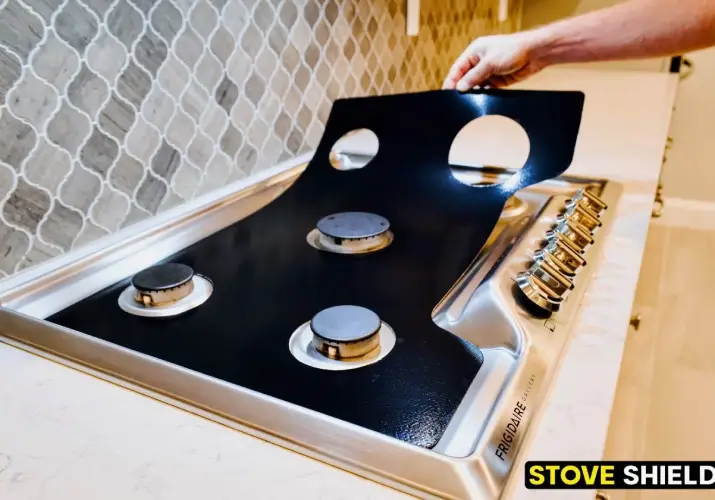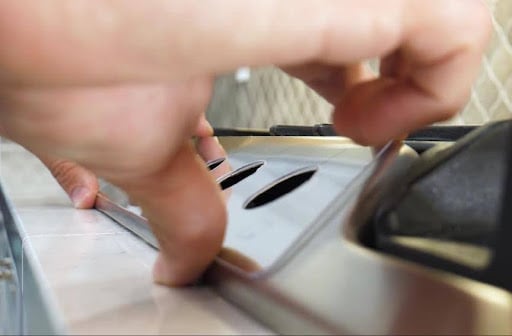Glass top gas stoves have become increasingly popular in modern kitchens — and for good reason. Their sleek, minimalist design adds a touch of elegance to any cooking space, while the smooth surface makes cleaning up spills and stains quick and easy. But despite their aesthetic appeal and user-friendly maintenance, these stoves aren’t without their drawbacks.
One of the most alarming issues users face is the unexpected cracking of the glass surface. Whether it’s a small hairline fracture or a full shatter, a damaged glass top can pose safety risks, disrupt your cooking routine, and lead to costly repairs or replacements.
In this blog, we’ll explore why some glass top gas stoves crack, the common causes behind the problem, early warning signs to watch for, and practical ways to prevent damage. We’ll also introduce reliable solutions—like Stove Shield—that add a layer of protection to your cooktop and extend its lifespan.
What Is a Glass Top Stove?
A glass top gas stove features a sleek layer of toughened glass or ceramic-glass mounted over traditional gas burners. This glass is engineered to withstand moderate to high temperatures, offering both form and function—combining the open flame cooking of gas with the stylish, seamless look of glass.
Key Benefits:
- Modern Aesthetics: The flat, glossy surface adds a contemporary touch to any kitchen.
- Easy Cleaning: Spills and stains wipe off easily without getting trapped in crevices.
- Heat Resistance: Toughened glass is designed to handle daily cooking heat and pressure from cookware.
How It Differs from Induction or Electric Ceramic Tops:
While they may look similar, glass top gas stoves differ significantly from induction or electric cooktops:
- Fuel Source: Gas tops use an open flame; induction and electric use electromagnetic or radiant heat.
- Surface Composition: Induction and electric cooktops often have smoother ceramic-glass finishes and flat heating elements below the glass.
- Heat Distribution: Induction stoves heat cookware directly, while gas stoves heat indirectly via flame, which means glass top gas stoves are more prone to uneven heat stress.
Understanding this structure is key to recognizing why cracking sometimes occurs—and how to protect your cooktop properly.
Can Glass on Gas Stoves Crack?
Yes — the glass on gas stoves can and does crack, often more frequently than many users expect. Despite being made from toughened or tempered glass, which is engineered for strength and heat resistance, these surfaces are not indestructible.
Cracks can range in severity:
- Minor (Hairline) Cracks: These often start small and may go unnoticed at first. They can gradually spread with repeated heat exposure or pressure.
- Major (Catastrophic) Shattering: In rare but serious cases, the entire glass surface can shatter—either from sudden impact, extreme heat fluctuations, or internal stress buildup.
Cracking not only compromises the stove’s appearance and functionality but also presents safety hazards such as sharp glass edges and exposed flames. That’s why understanding the causes—and taking steps to prevent them—is essential for every glass top gas stove owner.
Main Reasons Why Glass Stove Tops Crack
Cracking in glass top gas stoves usually results from a combination of stress, heat, and user habits. Here are the most common causes:
- Thermal Shock
One of the leading culprits is thermal shock, which occurs when the glass surface experiences a sudden change in temperature—such as pouring cold water or placing a chilled pan on a hot stove.
Tempered glass expands when heated and contracts as it cools. Rapid changes can stress the glass beyond its limits, leading to hairline cracks or sudden shattering. - Impact Damage
Heavy cookware, cast iron pans, or even dropping a metal lid can chip or fracture the glass surface.
While a small chip might seem harmless, repeated heating can cause it to spread into a full crack over time, especially if it’s near a burner where temperatures fluctuate. - Improper Installation
Installing the stove on an uneven surface or over-tightening mounting screws can create stress points. If the burners are misaligned or there are gaps between the glass and frame, heat and pressure are distributed unevenly, raising the risk of cracking. - Poor-Quality or Worn-Out Glass
Not all glass is created equal. Some stoves use lower-grade tempered glass rather than durable ceramic-glass. Over time, even high-quality glass can develop micro-fractures, worn seals, or lose its heat resistance—especially in older models. - Cooking Practices That Create Hot Spots
Placing oversized pans that cover multiple burners or setting cookware off-center can trap heat beneath the pan. This localized stress builds up in specific areas of the glass, increasing the likelihood of cracking from the inside out. - Manufacturing Defects or Internal Weakness
In rare cases, internal flaws during manufacturing—like air bubbles, poor bonding, or untreated stress zones—can lead to unexpected failures. These defects may not be visible but can weaken the integrity of the glass over time.
By recognizing these causes, users can adjust their habits and take proactive steps to avoid damage—starting with how the stove is used and protected.
Warning Signs That a Crack May Be Developing
Cracks in glass top gas stoves don’t always happen suddenly. Often, the glass gives off subtle warning signs before a visible fracture appears. Recognizing these early indicators can help prevent more serious damage or a complete failure of the cooktop.
- Hazy or Discolored Areas Under the Surface:
Cloudy spots or a slight rainbow tint beneath the glass may signal internal stress or heat damage building up over time. - Unusual Heat Buildup in Certain Zones:
If a specific burner area feels much hotter than usual or causes cookware to overheat quickly, it could be due to trapped heat or compromised glass structure. - Minor Scratches or Chips Along Edges:
Small edge imperfections often go unnoticed, but these are the most vulnerable points where cracks typically begin, especially under regular heat exposure. - Clicking or Creaking Sounds While Cooking:
Glass should be silent during operation. Unusual popping, clicking, or creaking noises can indicate expansion stress or a growing fracture beneath the surface. - Uneven Flames Near the Glass Surface:
If flames begin to flicker irregularly or lean to one side, it might point to distortion in the glass or underlying burner misalignment—both of which stress the cooktop structure.
Paying attention to these signs allows you to take immediate action—like avoiding that burner, letting the surface cool, or adding a protective barrier such as Stove Shield to prevent further damage.
How to Prevent Glass Stovetop Cracking
While glass top gas stoves are engineered to handle heat and daily use, their longevity depends on how you care for them. Here are proven tips to prevent cracking and extend the life of your cooktop:
- Use the Right Cookware
Choose flat-bottomed, medium-weight pots and pans that distribute heat evenly across the surface.
Avoid heavy cookware like cast iron, unless you’re using a heat diffuser to soften the pressure and reduce direct thermal impact on the glass. - Avoid Sudden Temperature Changes
Thermal shock is a major cause of cracking.
Never pour cold water on a hot glass surface, and always allow the stove to cool completely before cleaning or placing anything cold on top. - Lift, Don’t Drag
Always lift cookware instead of sliding it across the surface.
Dragging pots and pans can cause scratches, chips, or micro-fractures that weaken the glass over time. - Install Properly and Check Burner Alignment
Ensure your stove is installed on a perfectly level countertop to prevent stress points.
Check that burner heads are aligned and that the flame doesn’t lick the glass directly, which can cause heat stress in concentrated areas. - Use a Protective Layer Like Stove Shield
Add an extra line of defense with Stove Shield, a fiberglass-reinforced PTFE stove top protector. It cushions the glass surface, absorbs mechanical stress, and shields it from direct heat exposure.
In addition to preventing cracks, Stove Shield also protects against spills, stains, and scratches, making maintenance easy and extending the life of your stove.
What To Do If Your Stove Glass Cracks
A cracked glass cooktop isn’t just a cosmetic issue—it’s a serious safety hazard. If you notice a fracture, take the following steps immediately:
- Stop Using the Stove Right Away
Turn off all burners and discontinue cooking immediately. Continued use can worsen the crack or lead to shattering, increasing the risk of injury or fire. - Let the Stove Cool Completely
Avoid touching or pressing on the crack. Let the glass cool down naturally, and keep the area clear of any items or activity until it’s safe. - Contact the Manufacturer or a Certified Repair Technician
Reach out to your stove’s manufacturer or an authorized technician. They can assess the damage and recommend a proper course of action, whether it’s a repair or full replacement. - Do Not Attempt DIY Fixes
Never try to patch, glue, or seal a cracked stove glass on your own. These quick fixes won’t withstand heat and can lead to dangerous outcomes. - Replace With OEM or Heat-Rated Glass Only
If replacement is necessary, always use OEM (original equipment manufacturer) parts or properly heat-rated glass. Using the wrong material can compromise your stove’s safety and performance.
To avoid this situation altogether, consider proactive protection—like installing a Stove Shield cover that absorbs impact and heat, reducing the risk of cracks before they start.
Cracked Glass Stove Repair Cost
Repairing a cracked glass stove top can be surprisingly expensive, depending on the severity of the damage, the stove model, and whether the glass can be replaced separately from the burners or control components.
Here’s what you can typically expect:
- Minor Crack or Chip Repair:
Unfortunately, minor cracks usually cannot be safely repaired. Heat and pressure make adhesives unreliable on cooking surfaces, so most technicians will recommend full replacement. - Glass Top Replacement Only:
For models where the glass panel is sold separately, expect to pay $150–$400 for the part, plus $100–$200 for labor. Total: $250–$600+. - Integrated Stove Top Units (Glass + Burners):
If your stove’s design doesn’t allow just the glass to be replaced, you may need to swap the entire cooktop assembly. This can cost $500–$1,000 or more, especially for premium or imported models. - OEM vs Aftermarket Parts:
OEM (original equipment) parts cost more but ensure compatibility and safety. Aftermarket glass may be cheaper but often lacks the heat resistance or warranty coverage.
Is It Worth Repairing?
In many cases, if the stove is older or out of warranty, the cost of replacing the glass might approach the price of a brand-new stove. That’s why prevention is more affordable and safer in the long run.
Installing a Stove Shield protective cover is a small investment that helps you avoid these costly repairs by shielding your glass top from stress, heat damage, and impact.
Conclusion
Glass top gas stoves offer the perfect blend of style and functionality—but they also require mindful care to stay safe and intact. While they’re designed to handle daily heat and pressure, cracks can still occur due to thermal shock, heavy impacts, poor installation, or even routine cooking habits.
By recognizing early warning signs, practicing safe usage, and installing your stove correctly, you can significantly reduce the risk of glass cracking. And for added peace of mind, using a protective layer like Stove Shield provides a durable, heat-resistant barrier that guards against impact, spills, scratches, and thermal stress.
Ultimately, prevention is far more affordable—and safer—than costly repairs or replacements. With the right habits and tools in place, your glass top stove can remain a beautiful, functional centerpiece of your kitchen for years to come.
Disclaimer: All information contained within this article is for informational purposes. always refer to your specific stove manual for safety and use instructions and guidance.


